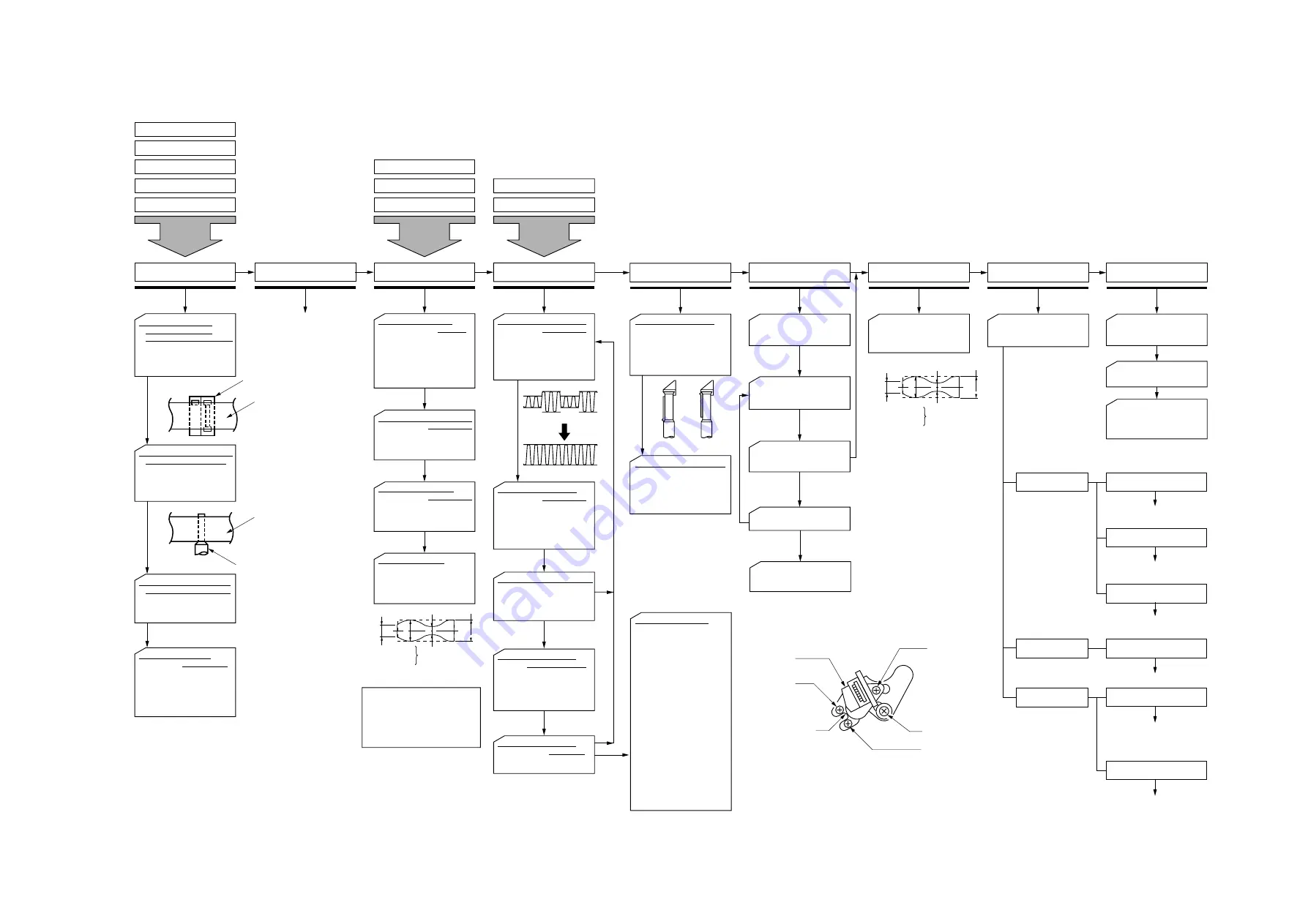
3.
(e)
No. 9 guide check (at REV mode)
(f)
Check for transitional operation
(g)
Recorded & reproduced
envelope check
(h)
Tape damage check
(i)
AFM envelope output max.
point check
1.
Guide roller section damage
Damage at No.8 guide brush
Damage at No.3 guide lower flange
Damage at No.8 guide flange
Damage at No.8 guide flange
Playback mode
Rewinding for synchronous
editing mode
Review mode
Back to step (c) linearity adjustment.
(or Slider assembly replacement)
Back to step (a) ACE head assembly
rough adjustment.
(or Pinch lever replacement)
Back to step (f) check for
envelope operation.
(or Tension lever replacement)
Back to step (e) No.9 guide lever
check or (a) ACE head assembly
rough adjustment.
(Pinch lever, No.9 lever,
Capstan motor replacement)
Back to step (c) linearity adjustment.
Back to step (c) linearity adjustment.
(or slider assembly replacement)
OK
NG
Checks for Hi-Fi models only.
Azimuth adjusting screw
ACE head
position securing
ACE height
adjusting screw
ACE head
Tilt adjusting screw
ACE head adjusting slit
(Insert a slot-type screwdriver.)
(A)
(B)
2.
4.
Damage at guide roller section
Head assembly (cylinder)
assembly replacement
S, T slider assembly replacement
ACE head assembly replacement
Capstan motor assembly
replacement
Pinch lever assembly replacement
(a)
ACE head assembly
rough adjustment
AUDIO HEAD HEIGHT
ADJUSTMENT (AUDIO
HEIGHT ADJUSTING SCREW)
(b)
Playback phase adjustment
Adjust as described in the Electrical
Adjustment Section (Servo circuit.) in
each service manual.
Tension lever assembly replacement
Impedance roller replacement
FE head replacement
(c)
Linearity adjustment
(S, T guide roller)
1. MAXIMUM ENVELOPE
OUTPUT
1. AUDIO HEAD HEIGHT FINE
ADJUSTMENT
1. TAPE WRINKLE CHECK
2. NO. 9 GUIDE ADJUSTMENT
2. ENTRANCE SIDE ENVELOPE
ADJUSTMENT
(Note 1)
Clutch gear assembly replacement
Reel table replacement
(d)
ACE head fine adjustment
OK
No.8 guide flange
Tape
Tape
Audio head
OK
NG
b
d
a
c
(S-VHS model)
(Non S-VHS model)
NG
1.
AUDIO HEAD TILT ADJUSTMENT
(TILT ADJUSTING SCREW)
2.
c/a
≥
0.75
b,d/a
≥
0.63
b,c,d/a
≥
0.75
5.
NG
b
d
a
c
(S-VHS model)
(Non S-VHS model)
c/a
≥
0.75
b,d/a
≥
0.63
b,c,d/a
≥
0.75
Playback the tape recorded in
SP mode. Align position of the
upper end of tape and that of
the audio head.
Playback the tape in SP mode
continuously. Adjust Audio head
tilt screw so that tape runs along
lower flange of No.8 guide
AUDIO AZIMUTH ADJUSTMENT
(AZIMUTH ADJUSTING SCREW)
3.
Playback 7 kHz audio signal on
alignment tape and adjust for
max. output.
ACE HEAD POSITION
ADJUSTMENT
4.
Playback video envelope
signal 2MHz (A ch) on
alignment tape in SP mode.
Reset tracking control at its
center. Adjust ACE main base
to obtain max. output.
Playback the white video
signal on the alignment tape.
Trigger scope with switching
pulse.
Adjust tracking control for maxi-
mum envelope output by
pushing tracking up/down
buttons.
Playback stereophonic
alternative recording signal
(300-500Hz) on alignment tape.
Turn the Audio height adjusting
screw until audio envelope
signal becomes as flat as
possible.
2. AUDIO HEAD TILT FINE
ADJUSTMENT
4. AUDIO HEAD AZIMUTH
FINE ADJUSTMENT
Playback alignment tape in CUE
or double speed mode.
Adjust Audio head tilt until tape
runs along lower flange of No.8
guide.
3. AUDIO HEAD HEIGHT CHECK
Playback signal as described in
step 1, make sure audio
envelope signal becomes as flat
as possible.
If tape travels out of upper/lower
flange as shown above, pinch
lever or capstan motor or No.9
guide lever is defective.
Replace the defective part (s).
Playback 7 kHz audio signal on
alignment tape.
Turn the azimuth adjusting
screw to obtain maximum
output.
5. AUDIO HEAD HEIGHT
RE-CHECK
Repeat same step as step 3.
Playback T-160 tape in
Review mode.
6. ACE HEAD POSITION
Set tracking at its center
position pressing tracking
up/down buttons
simultaneously.
Playback white video signal
(SLP mode) on the alignment
tape. Slide ACE main base to
obtain max. envelope.
Playback 2 MHz video signal
(SLP mode) on the alignment
tape.
Confirm that difference from
tracking center is within 3 ms
when maximum envelope is
obtained.
If not, readjust in SLP mode.
Confirm the portion of upper/
lower flange on No.8 guide.
Playback white video signal
(SLP mode) in alignment tape
and set review mode.
Records signals in SP & SLP
modes, using T-120,
T-160 tape and playback
them to check envelopes.
Run T-160 tape in each mode
and check there is no damage
at each guide.
Playback 3 MHz video signal.
400 Hz AFM signal in alignment
tape ST-NF in SP mode.
Check control pulse phase
difference is within ± 3 ms from
that point to AFM envelope max.
point.
Check video envelope max. point
(A-ch).
Change mode from review to
play and check entrance side
envelope rises within 3s.
Check entrance side envelope
rised within 3s, when mode is
changed from slot-in to play.
Adjust S guide roller to readjust
linearity.
Check step 2 and 3 if no good,
replace S slider assembly or
tension lever.
Rotate S guide roller until
entrance side envelope
becomes as flat as possible.
3. EXIT SIDE ENVELOPE
ADJUSTMENT
Rotate T guide roller until exit
side envelope becomes as flat
as possible.
4. LINEARITY CHECK
Press the tracking up/down
buttons alternately, make sure
envelope increases or de-
creases with flat response kept.
(Note 1)
For the linearity adjustment (c),
make sure adjusted value should
be checked with 2 MHz/SP mode
after completion of specified
adjustments using 30 % white (SLP)
signal in alignment tape.
*
VTR applied SP mode only, use
2 MHz (A ch) video signal instead
of white video signal (SLP mode).
(2) Tape Transport System Adjustment Flowchart
Fig. 1-7-4






























